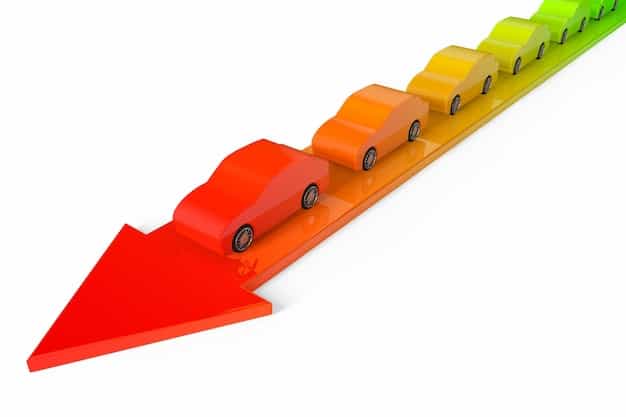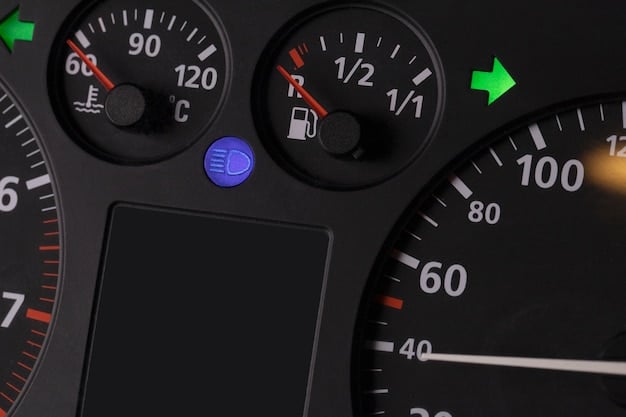Car Buying Guide 2025: Depreciation and Resale Value

Car Buying Guide 2025: Understanding the Depreciation Curve and Its Impact on Resale Value explores strategies to navigate vehicle depreciation, make informed purchasing decisions, and maximize long-term resale value.
Navigating the car market requires understanding the often-overlooked aspect of depreciation. This Car Buying Guide 2025: Understanding the Depreciation Curve and Its Impact on Resale Value equips you with the knowledge to make informed decisions and protect your investment.
Understanding Vehicle Depreciation: A 2025 Perspective
Vehicle depreciation is the decline in a car’s value over time. It’s an inevitable factor to consider when buying a car, whether new or used. Understanding how depreciation works can significantly impact your financial planning and future resale prospects.
Factors Affecting Depreciation
Several factors influence how quickly a car depreciates. Understanding these can help you make a smarter purchase.
- Make and Model: Some car brands and models hold their value better than others.
- Mileage: Higher mileage generally leads to faster depreciation.
- Condition: A well-maintained car will depreciate less than one in poor condition.
- Market Demand: Popular models tend to depreciate slower due to higher demand.
Depreciation is most rapid in the first few years of ownership. A new car can lose a significant portion of its value as soon as it’s driven off the lot.

The Depreciation Curve: What to Expect in 2025
The depreciation curve illustrates how a vehicle’s value decreases over its lifespan. Knowing what to expect can shape your buying strategy.
The initial depreciation is often the steepest. This is due to the immediate switch from “new” to “used” status.
New vs. Used Car Depreciation
New cars depreciate more quickly in the first few years than used cars. A used car has already absorbed a significant portion of its initial depreciation.
- New Car: Expect a larger drop in value initially.
- Used Car: Depreciation is slower but ongoing.
- Certified Pre-Owned (CPO): Offers some depreciation benefits with added warranty.
By 2025, electric vehicles (EVs) are becoming increasingly popular. Their depreciation curves can differ from traditional gasoline cars due to factors like battery life and technology advancements.
Maximizing Resale Value: Tips for Car Buyers in 2025
There are several strategies to minimize depreciation and maximize resale value. Strategic buying habits and proper maintenance go a long way.
Choosing the right vehicle is the first step. Research models known for retaining their value.
Choosing the Right Car
- Research: Check Kelley Blue Book and other sources for resale value predictions.
- Consider Demand: Opt for popular models that tend to hold their value better.
- Think Long-Term: Choose a car that fits your needs for the foreseeable future.
Regular maintenance is crucial. Keeping your car in excellent condition will help it retain its value over time.
Maintenance and Care: Preserving Your Car’s Value
How you care for your car directly impacts its resale value. Regular maintenance is key to slowing depreciation.
Following the manufacturer’s recommended service schedule is essential. This includes oil changes, tire rotations, and other routine maintenance tasks.
Essential Maintenance Practices
Implementing these practices will improve your car’s appearance and functionality, preserving its value.
- Regular Washing and Waxing: Protects the paint and prevents rust.
- Interior Cleaning: Keeps the interior fresh and prevents wear and tear.
- Prompt Repairs: Address any mechanical issues promptly to prevent further damage.
Keeping detailed service records demonstrates to potential buyers that the car has been well-maintained. This can bolster confidence and justify a higher selling price.

Understanding Trim Levels and Options: Investment Considerations
Trim levels and optional features can significantly influence a car’s resale value. Knowing which ones to prioritize can be a smart investment.
Higher trim levels often come with desirable features that can enhance resale value. However, it’s important to weigh the cost against the potential return.
Popular Options That Boost Resale Value
Certain options consistently add value to a car since they are highly coveted.
- Safety Features: Advanced driver-assistance systems (ADAS) are increasingly desirable.
- Technology Package: Infotainment systems and connectivity features are key.
- Premium Audio: High-quality sound systems can attract buyers.
Opting for popular colors and configurations can also make your car more appealing to a wider range of buyers, thereby improving its resale prospects.
The Impact of Technology on Depreciation in 2025
Advancements in automotive technology are rapidly evolving. Understanding how these changes affect depreciation is increasingly important.
Electric vehicles (EVs) and hybrid cars are becoming more prevalent. Their unique technological factors influence their depreciation rates.
EV Depreciation Factors
Several key factors differentiate EV depreciation from traditional models.
- Battery Life: Battery health and replacement costs are significant concerns.
- Charging Infrastructure: The availability of charging stations impacts demand.
- Technological Advancements: Rapid advancements in battery technology can quickly make older models obsolete.
Keeping abreast of these technological advancements and their potential impact on vehicle values is crucial for making informed decisions in the car market.
Leasing vs. Buying: Depreciation and Financial Implications
Deciding between leasing and buying a car involves different approaches to depreciation. Each option has distinct financial implications.
When you lease a car, you essentially pay for the portion of the vehicle’s value that you use during the lease term. Depreciation is a central factor in calculating lease payments.
The Financial Implications of Leasing and Buying
Here’s a brief overview to aid in your decision making.
The depreciation curve is a vital tool for assessing the long-term value of your car. By understanding how depreciation affects different vehicles and adopting proactive strategies, you can minimize its impacts. Remember that depreciation is most rapid in the first few years but that maintenance and care will preserve your car’s value.
| Key Point | Brief Description |
|---|---|
| 📉 Depreciation Factors | Make, model, mileage, condition, and market demand affect depreciation. |
| 💰 Resale Maximization | Choose wisely, maintain well, and consider options that increase value. |
| ⚡️ Technology Impact | EV batteries and technological advancements can rapidly affect car values. |
| ✔️ Maintenance Matters | Regular servicing and prompt repairs help maintain your car’s value. |
Frequently Asked Questions
▼
New cars typically depreciate the most within the first year, often losing 20-30% of their value as soon as they are driven off the lot. After that initial drop, the depreciation rate slows down.
▼
Several factors influence resale value, including brand reputation, model popularity, reliability ratings, and consumer demand. Well-maintained vehicles also hold their value better than those in poor condition.
▼
Mileage is a significant depreciation factor. Higher mileage generally indicates more wear and tear, which can lower the car’s value. However, well-maintained vehicles with higher mileage can still hold reasonable value.
▼
Yes, EVs have different depreciation factors. Battery health, charging convenience, and technological improvements play a huge role, since they quickly make older models obsolete. Regular servicing keeps the value high.
▼
Yes, regular maintenance and proper care help. Keeping your car clean, addressing repairs promptly, and storing service records are good steps to take. Choosing popular options, such as safety features, help also.
Conclusion
Understanding vehicle depreciation is essential for all car buyers. By considering the factors discussed and taking proactive steps, you can make informed decisions that maximize value and minimize financial losses. As we move into 2025, staying informed about market trends and technological advancements will become even more vital.





